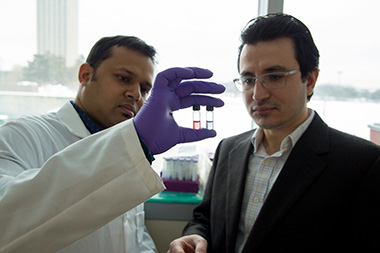Biochemist’s Technique Rapidly Detects Ebola Virus
.jpg) |
|
Biochemist Mehmet Yigit (left) and graduate student researcher Muhit Rana. (Photo by Carlo De Jesus)
|
ALBANY, N.Y. (February 16, 2017) – In 2014, the most widespread Ebola virus outbreak in history wreaked havoc in Western Africa. The epidemic resulted in more than 28,000 reported cases and 11,315 deaths over 21 months.
Biochemist Mehmet Yigit finds those numbers unacceptable.
Yigit, an assistant chemistry professor and affiliated faculty member in UAlbany's The RNA Institute, has developed a new, cost-effective technique that can rapidly detect Ebola and other deadly illnesses. It would allow more people to be diagnosed and treated in a shorter time period.
His technique first identifies disease biomarkers that are found in human urine. Then, by using gold nanoparticles, the research team, led by UAlbany graduate students Mustafa Balcioglu and Muhit Rana, visually-detect within minutes if the associated biomarkers are present in a person’s urine sample. The sample turns red if infected, purple if not.
To confirm the detection, Yigit’s team measures the amount light absorbed by the infected sample at a given wavelength – also known as absorbance spectroscopy.
 |
|
Yigit's team can detect Ebola Virus biomarkers within minutes. Through their technique, a human urine sample turns red if infected. (Photo by Carlo De Jesus) |
“Our goal is to assemble a small kit that can be used for rapid disease screening,” said Yigit. “The current detection methods for Ebola, and other diseases, are costly, time-consuming and require sophisticated equipment. We are working to make real-time detection a reality. This will narrow the population who need to be tested through conventional methods.”
In total, 25 urine samples spiked with four Ebola-associated biomarkers were tested by Yigit’s team. The technique provided accurate results in 24 samples, including each of the four subtypes of Ebola that infect humans. The researchers needed just one fifth of 1 milliliter of a sample to identify if it was infected.
Full results were published last month in Advanced Healthcare Materials.
Yigit said the Ebola results serve as only a model for the potential of his methodology. Previously, his team published findings in Chemical Communications on identifying biomarkers from breast cancer cells. They also released a second paper last month in Chemical Science on visual detection of mercury in different environmental and biological sources (urine, water, and soil).
The lab is currently considering Zika virus biomarker detection.
“We are not biologists or classical biochemists. We are materials scientists developing methodologies for biomedical and environmental challenges by looking at them from a different angle,” Yigit said. “Our approach can be implemented in any scenario where the associated biomarkers and their recognition elements are identified. It has a broad application spectrum.”
Yigit’s research is supported by internal funding from UAlbany start-up funds. He was also the recipient of the University’s Presidential Initiatives Fund for Research and Scholarship, the SUNY Health Network of Excellence Award and the SUNY Network of Excellence Award in Materials and Advanced Manufacturing.
“The funding I’ve received from the University has enabled me to work independently and obtain everything I need for my research to be successful,” Yigit said. “I am thankful to be surrounded by incredibly supportive faculty and hard-working student research assistants.”
Learn more about Yigit by visiting his official University faculty page. You can also visit his lab’s website.
![]() For more news, subscribe to UAlbany's RSS headline feeds
For more news, subscribe to UAlbany's RSS headline feeds
A comprehensive public research university, the University at Albany-SUNY offers more than 120 undergraduate majors and minors and 125 master's, doctoral and graduate certificate programs. UAlbany is a leader among all New York State colleges and universities in such diverse fields as atmospheric and environmental sciences, business, education, public health,health sciences, criminal justice, emergency preparedness, engineering and applied sciences, informatics, public administration, social welfare and sociology, taught by an extensive roster of faculty experts. It also offers expanded academic and research opportunities for students through an affiliation with Albany Law School. With a curriculum enhanced by 600 study-abroad opportunities, UAlbany launches great careers.


